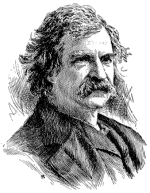The Boys’ Life of Mark Twain
by Paine

XXXVI. The New Home
The new home in Hartford was ready that autumn–the beautiful house finished, or nearly finished, the handsome furnishings in place. It was a lovely spot. There were trees and grass–a green, shady slope that fell away to a quiet stream. The house itself, quite different from the most of the houses of that day, had many wings and balconies, and toward the back a great veranda that looked down the shaded slope. The kitchen was not at the back. As Mark Twain was unlike any other man that ever lived, so his house was not like other houses. When asked why he built the kitchen toward the street, he said:
“So the servants can see the circus go by without running into the
front yard.”
But this was probably his afterthought. The kitchen wing extended toward Farmington Avenue, but it was a harmonious detail of the general plan.
Many frequenters have tried to express the charm of Mark Twain’s household. Few have succeeded, for it lay not in the house itself, nor in its furnishings, beautiful as these things were, but in the personality of its occupants–the daily round of their lives–the atmosphere which they unconsciously created. From its wide entrance-hall and tiny, jewel like conservatory below to the billiard-room at the top of the house, it seemed perfectly appointed, serenely ordered, and full of welcome. The home of one of the most unusual and unaccountable personalities in the world was filled with gentleness and peace. It was Mrs. Clemens who was chiefly responsible. She was no longer the half- timid, inexperienced girl he had married. Association, study, and travel had brought her knowledge and confidence. When the great ones of the world came to visit America’s most picturesque literary figure, she gave welcome to them, and filled her place at his side with such sweet grace that those who came to pay their dues to him often returned to pay still greater devotion to his companion. William Dean Howells, so often a visitor there, once said to the writer:
“Words cannot express Mrs. Clemens–her fineness, her delicate,
wonderful tact.” And again, “She was not only a beautiful soul, but
a woman of singular intellectual power.”
There were always visitors in the Clemens home. Above the mantel in the library was written: “The ornament of a house is the friends that frequent it,” and the Clemens home never lacked of those ornaments, and they were of the world’s best. No distinguished person came to America that did not pay a visit to Hartford and Mark Twain. Generally it was not merely a call, but a stay of days. The welcome was always genuine, the entertainment unstinted. George Warner, a close neighbor, once said:
“The Clemens house was the only one I have ever known where there
was never any preoccupation in the evenings and where visitors were
always welcome. Clemens was the best kind of a host; his evenings
after dinner were an unending flow of stories.”
As for friends living near, they usually came and went at will, often without the ceremony of knocking or formal leave-taking. The two Warner famines were among these, the home of Charles Dudley Warner being only a step away. Dr. and Mrs. Harriet Beecher Stowe were also close neighbors, while the Twichell parsonage was not far. They were all like one great family, of which Mark Twain’s home was the central gathering-place.
 Continue...
Continue...![[Buy at Amazon]](http://images.amazon.com/images/P/B0006AHKG6.01.MZZZZZZZ.jpg)